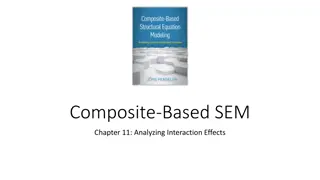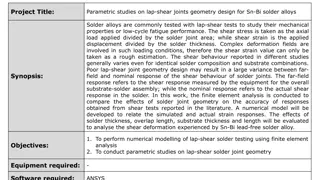Internal Loadings in Structural Members
Internal loadings in structural members, such as beams and frames, are essential for design. This chapter explores the analysis of shear forces, bending moments, and axial forces, providing methods to determine these forces graphically using shear and moment diagrams. Learn about the sign convention
1 views • 35 slides
Analyzing Interaction Effects in Composite-Based SEM
Explore the concept of interaction effects in composite-based structural equation modeling (SEM) through topics like the logic of interaction, estimating effects, multigroup analysis, and visualizing effects. Learn about moderators, their role in relationships between variables, and techniques for a
2 views • 23 slides
Viscoelasticity and Relaxation in Amorphous Materials
Dive into the world of viscoelasticity and relaxation in amorphous materials, exploring concepts like complex shear modulus, Maxwell element, and phenomenological models. Discover the intriguing nature of glass, its transition between solid and viscous states, and the various theories surrounding it
1 views • 34 slides
Unique Aspects of Ship Structures
Ships have complex three-dimensional shapes and support structures to withstand dynamic loads in various environments. Structural loads such as weight and buoyancy are distributed forces that affect shear stress in ship structures. Strategies to reduce shear stress include matching buoyancy and weig
1 views • 58 slides
Interaction Effects in Regression Analysis using SAS 9.4
Regression models help analyze effects of independent variables (IVs) on dependent variables (DVs, like weight loss from exercise time). Interactions explore how one IV's effect can be modified by another IV (moderating variable, MV). In this seminar's purpose, techniques to estimate, test, and grap
1 views • 137 slides
Shear Stress in Mechanics of Materials
Shear stress is a critical concept in Mechanics of Materials, describing the stress parallel to a surface due to applied forces. This stress is crucial in various applications like metal joints, punching operations, and more. Shear stress calculations can help engineers determine the strength and du
0 views • 19 slides
Insights into the Low-Latitude Boundary Layer in Mercury's Magnetosphere
Study focuses on the low-latitude boundary layer (LLBL) in Mercury's magnetosphere, analyzing magnetosphere and magnetosheath plasma characteristics such as reconnection rates, IMF/magnetic shear, and plasma beta. Results show anti-correlation between LLBL and non-LLBL regions, with different reconn
0 views • 11 slides
Unstable Weather Alert: Tropical System Impact and Shear Line Approaching
Tropical system passing north, bringing heavy rainfall and unstable air. Expect convective showers, tailwinds on landing, and shifting precipitation patterns. Concerns about tropical showers, moisture levels, and shear line impact on landing and takeoff conditions. Images of weather situations provi
2 views • 10 slides
Experimental Study on Wind Shear Effects on Laser Propagation
Research conducted by Joe Watkins, Reza Malek-Madani, and Svetlana Avramov-Zamurovic to analyze the impact of wind shear on laser propagation. The experiments involved a HeNe red laser passing through a tunnel with varying wind speeds. Data on light intensities and wind influence were collected and
0 views • 7 slides
Beam Elements and Shear Effects in Structural Analysis
Beam elements play a crucial role in structural analysis, offering insights into line elements with various degrees of freedom for bending modes and stress analysis. Shear deflection and stresses in beams are essential considerations when accounting for shear effects. Learn about real constants, sha
1 views • 16 slides
Shear and Moment in Beams
Beams play a crucial role in mechanical engineering, with two main types - statically determinate and indeterminate beams. Explore the definition of beams, loading types, and the concept of shear and moment diagrams to understand the behavior of beams under different loads and reactions. Learn how t
0 views • 8 slides
Cosmic Shear Measurement in Fourier Space and Its Scientific Goals
Exploring the cosmic shear in Fourier space with a collaborative effort led by Jun Zhang from Shanghai Jiao Tong University sheds light on fundamental scientific questions related to dark energy, the geometry of the universe, General Relativity, cold dark matter, and cosmic structure density distrib
0 views • 48 slides
Research on Stratospheric Polar Vortex and TPVs for Arctic Cyclone Predictability
This research aims to enhance predictability of Arctic cyclones by studying the Stratospheric Polar Vortex and Tropopause Polar Vortices (TPVs). The presence of strong westerly winds in the stratosphere during fall leads to anomalous cold air outbreaks in mid-winter. TPVs serve as precursors to arct
0 views • 4 slides
Influence of Vertical Wind Shear on Entrainment in Squall Lines
The strength and direction of low-level (LL) and upper-level (UL) wind shear influence the properties of squall line updrafts, with stronger shear environments fostering wider updrafts that are less susceptible to entrainment-driven dilution. The relative influences of LL and UL shear on this relati
0 views • 40 slides
Media Effects on Development: Strong, Limited, and Nil Impact (Continuation)
American psychologists have traditionally believed in strong media effects, attributing direct influence on audiences. However, the limited effects theory emerged in the 1940s, challenging this notion by suggesting media's negligible impact on behaviors such as voting. On the other hand, proponents
0 views • 6 slides
Persistence of Langmuir Modes in Complex Shear Flows
Exploring the persistence of Langmuir modes in kinematically complex plasma flows with a focus on shear flows in nature and historical backgrounds. The research delves into the methodology of classical theory and introduces the nonmodal approach to address limitations. Details on shear flow definiti
0 views • 16 slides
Viscous Fluid Behavior in Engineering Applications
Viscosity is a crucial property in fluid mechanics, impacting how fluids deform and move. Engineers measure viscosity using factors like resistance to deformation and fluid behavior classifications such as Newtonian, shear thinning, shear thickening, and Bingham plastic. This knowledge is essential
1 views • 7 slides
Describing Rheological Properties of Unknown Materials - In-Class Activity (Spring 2015)
Explore the rheological properties of unknown materials in a hands-on in-class activity. Students work in teams to identify whether samples are pseudoplastic, Newtonian, or dilatant fluids based on viscosity changes with shear rate. Corn syrup, corn starch, icing, and toothpaste are analyzed, with f
0 views • 5 slides
Collective Effects in High-Energy Physics Facilities
Collective effects play a crucial role in Higgs factories and high-energy physics facilities. Impedance effects are proportional to beam-induced voltage, with peak bunch current impacting SB effects and average current affecting MB effects. Factors like beam loading compensation and detuning of the
2 views • 5 slides
Shear Strength in Engineering Materials
Shear strength is a crucial mechanical property that defines a material's ability to resist forces causing internal structure to slide. This property plays a significant role in various engineering fields, impacting design, construction, and material selection. Shear strength is essential in prevent
0 views • 31 slides
Capillary Rheology: A Guide to High-Shear Behavior
Capillary rheology is a study of materials that flow, combining properties of liquids and solids. By passing liquids through small tubes, capillary rheology allows for the analysis of high-shear behavior, crucial for processes like extrusion and coating. Learn about the basic terms, anatomy of a cap
0 views • 29 slides
Deformation and Strain in Engineering
Deformation occurs when a force is applied to a body, causing changes in its shape and size. Normal strain refers to the elongation or contraction of a line segment per unit length, while shear strain is the change in angle between two originally perpendicular line segments. Cartesian strain compone
0 views • 6 slides
Strain and Stress: Concepts and Applications for Geologists and Geophysicists
This content delves into various aspects of stress and strain in the context of geology and geophysics, exploring the physical meanings of unit vectors, stress matrices, strain matrices, pure shear, simple shear, and their implications on deformation characteristics. It also discusses scenarios wher
0 views • 4 slides
Extended Examples of Fixed and Random Effects Models for Panel Data Analysis
Fixed and random effects models in panel data using Stata, as presented by Dr. Kevin Ralston from the University of Edinburgh. Learn about the structure of panel data, the Fixed Effects (FE) model which controls for stable unobserved variables, and the Random Effects (RE) model which considers rando
0 views • 9 slides
Plough Shear Mixer - Machinery for Pharmaceuticals
Plough Shear Mixer is a crucial component for processing industries such as pharmaceuticals, cosmetics, chemicals, and food. With features like high-speed mixing and easy cleaning, this equipment delivers efficient and homogenous mixing results. Contact Siddhi Pharma Equipment for expert guidance an
0 views • 4 slides
Rock Mechanics TEC 18
TISHK INTERNATIONAL UNIVERSITY professor Dr. Hamed M. Jassim explores shear strength behavior of rock discontinuities. Discover Barton's estimate for shear strength and the non-linear strength criterion for rock joints developed by Barton and Choubey. Learn about joint roughness coefficients, compre
0 views • 33 slides
Parametric Studies on Lap-Shear Joints Geometry Design for Sn-Bi Solder Alloys
Solder alloys like Sn-Bi are commonly tested with lap-shear tests to study mechanical properties and low-cycle fatigue performance. The study focuses on finite element analysis to evaluate the effects of solder joint geometry on shear deformation. It involves developing a numerical model to compare
0 views • 5 slides
Shaft Stress Analysis and Design Equations
This content discusses the analysis and design considerations for shafts under shear stress, bending moment, and combined states of stress. It covers stress distribution, equations for solid and hollow shafts, and important theories for shaft design. The material provides insights into determining s
0 views • 21 slides
Ultrasound Shear Wave Elastography in Cardiology and Ultrasound
This article explores the application of ultrasound shear wave elastography in cardiology and ultrasound imaging. It covers the principles of shear wave elastography, its use in assessing tissue stiffness, and the proposed SR template for elastography of organs/tissues such as the liver, breast, and
0 views • 5 slides
John Deere FB20 Shear Felling Head (SNWCFB20X001001-Present) Operator’s Manual Instant Download (Publication No.OMF381448)
John Deere FB20 Shear Felling Head (SNWCFB20X001001-Present) Operator\u2019s Manual Instant Download (Publication No.OMF381448)
0 views • 20 slides
Survey Mode Impact on Data Quality: Evidence from Nigeria Experiment
This study explores the impact of survey modes on data quality in Nigeria, focusing on phone surveys in LMICs. The experiment aims to identify mode effects on various outcome variables crucial for policymakers and researchers. The research addresses gaps in pure mode effects evidence and aims to pro
0 views • 43 slides
Geotechnical Engineering: Shear Strength and Soil Characteristics
Explore the complexities of shear strength in unsaturated clays, sensitivity classifications, thixotropy effects, and activity classification in geotechnical engineering. Learn about pore fluid pressure coefficients, Mohr-Coulomb equations, and the impact of water content on soil strength.
0 views • 27 slides
Understanding Shear Conditions in Soil Mechanics
Learn about shear deformation of soil, peak shear stress, critical state, types of soils under shearing conditions, drained vs undrained conditions, and more in soil mechanics and foundations. Explore the differences between Type I and Type II soils and how they behave under various loading conditio
0 views • 4 slides
Mastering Adobe Premiere Effects for Stunning Video Creations
Delve into the vast array of effects available in Adobe Premiere, from basic adjustments to intricate visual enhancements. Learn about Fixed Effects, Standard Effects, and Track-Based Effects, as well as adding Plugins for expanded capabilities. Discover how to apply Transition Effects seamlessly to
0 views • 9 slides
Understanding Shear Tester Simulations Using Force-Controlled Walls
Explore the application of force-controlled walls in shear tester simulations, including material properties, experimental setups, and numerical modeling. Gain insights into coefficient of friction determination and the Jenike shear tester. Join the LAMMPS workshop for practical knowledge.
0 views • 14 slides
Shear Stress in Beams: Understanding and Deriving Formulas
Explore the concept of shear stress in beams, the distribution resulting from bending moments, and the derivation of shear stress formulas in mechanics of materials. Understand the role of transverse shear forces and how they contribute to equilibrium in beams.
0 views • 9 slides
Plough Shear Mixer for Pharmaceuticals, Cosmetics, and Chemical Industries
Siddhi Pharma Equipment specializes in manufacturing and exporting plants and machineries for pharmaceuticals, cosmetics, chemicals, food, and beverage industries. Their Plough Shear Mixer is designed for high-speed and homogenous mixing with features such as vacuum/pressure inside the mixer, heatin
0 views • 4 slides
Understanding Load, Shear, and Bending Moment in Engineering Mechanics
Explore the relationships among load, shear, and bending moment in statics with detailed examples, calculations, and solutions presented in a simple and informative manner. See how forces and reactions affect beams in structural analysis.
0 views • 25 slides
Parametric Studies on Lap-Shear Joints Geometry Design for Sn-Bi Solder Alloys
Explore the effects of solder joint geometry on Sn-Bi solder alloy behavior through finite element analysis. Investigate the impact of parameters like solder thickness, overlap length, and substrate dimensions on shear deformation. Compare simulated responses with actual strain behaviors to enhance
0 views • 5 slides
Understanding Mechanical Engineering Fundamentals - Loads, Stress, and Strain
Dive into the fundamentals of mechanical engineering, exploring the concepts of loads, stress, and strain. Learn about different types of loads, unit stress, unit strain, tensile and compressive stress and strain, shear stress and strain, as well as properties like Young's Modulus and Shear Modulus.
0 views • 9 slides







































